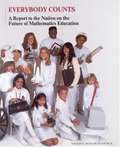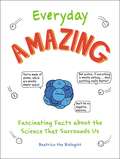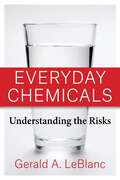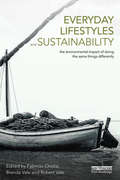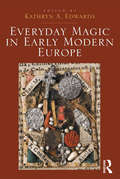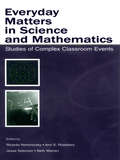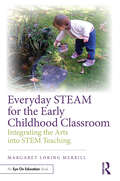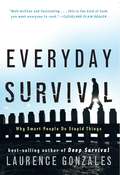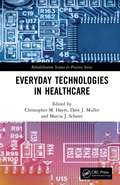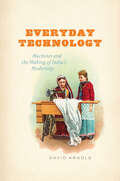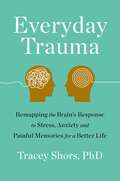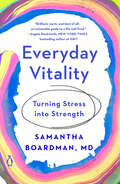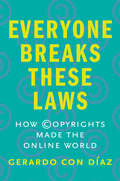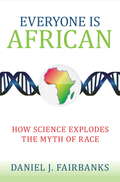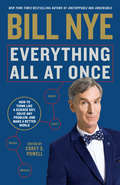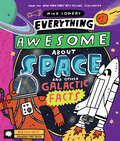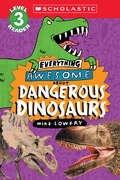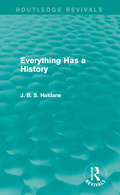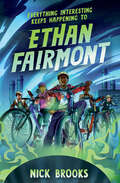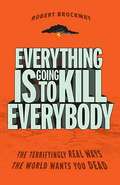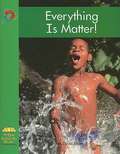- Table View
- List View
Everybody Counts: A Report to the Nation on the Future of Mathematics Education
by Mathematical Sciences Education BoardMathematics is the key to opportunity. No longer only the language of science, mathematics is now essential to business, finance, health, and defense. Yet because of the lack of mathematical literacy, many students are not prepared for tomorrow's jobs. Everybody Counts suggests solutions. Written for everyone concerned about our children's education, this book discusses why students in this country do not perform well in mathematics and outlines a comprehensive plan for revitalizing mathematics education in America, from kindergarten through college. single copy, $8.95; 2-9 copies, $7.50 each; 10 or more copies, $6.95 each (no other discounts apply).
Everyday Amazing: Fascinating Facts about the Science That Surrounds Us
by Beatrice the BiologistLike fan mail addressed to the natural world, Everyday Amazing is filled with uplifting and interesting musings on science from Beatrice the Biologist. Beatrice the Biologist is an easily amused former high school biology teacher with a soft spot for the mind-blowing science we encounter daily that we often take for granted. In Everyday Amazing, she shines the spotlight on ten different types of amazing everyday scientific facts in short chapters full of fun and fascinating tidbits bound to both entertain you and expand your horizons! Learn the basics of atomic science, sound waves, bioscience, microbiology, and more in accessible chapters offering a fresh perspective on concepts you may have learned about, but aren’t totally clear on. Quirky illustrations throughout add to the fun! Fall in love with science with Beatrice the Biologist in Everyday Amazing!
Everyday Chemicals: Understanding the Risks
by Gerald A. LeBlancWhat is the likelihood that common chemicals such as bisphenol-A, which is found in plastic water bottles, are harming us? Should shoppers be concerned about pesticide residues on fruits and vegetables in the supermarket produce aisle? Are we risking adverse health effects when we use insect repellent that contains DEET or slather on sunscreen? Modern life requires us to navigate an endless sea of chemicals. How do we know whether we need to worry about them?This book is a layperson’s guide to understanding chemical risk. The toxicologist Gerald A. LeBlanc offers a nontechnical overview of the key factors in evaluating whether exposure to chemicals in our daily lives could be harmful. He leads readers through the basic concepts of risk assessment using real-world examples. LeBlanc emphasizes that chemical hazard depends on the level of exposure and provides practical strategies for sensible decision making. The book features a series of accessible case studies describing how we all can reach rational conclusions about the danger of typical chemical exposures we experience every day.Giving nonexpert readers the tools to understand chemical risks, this book shows how critical thinking and science literacy can help us live with less fear and anxiety and make reasonable choices when confronted with potential hazards.
Everyday Energy
by Smithsonian InstitutionEveryday Energy Is part of the Smithsonian Science Stories™ Literacy Series and has on-grade and below-grade leveled readers available to accommodate a range of readers in an elementary classroom. The line and dot graphic at the bottom of the front cover indicates the reading level. When the dot is at the top of the line, the reading level for the book is on-grade. When it is at the bottom, the book is below-grade. You can also find the official Lexile Scores for each reading in the Table of Contents. The books in this literacy series enhance and reinforce the science concepts taught in the Smithsonian Science for the Classroom™ curriculum units.
Everyday Lifestyles and Sustainability: The Environmental Impact Of Doing The Same Things Differently
by Robert Vale Brenda Vale Fabricio ChiccaThe impact of humanity on the earth overshoots the earth’s bio-capacity to supply humanity’s needs, meaning that people are living off earth’s capital rather than its income. However, not all countries are equal and this book explores why apparently similar patterns of daily living can lead to larger and smaller environmental impacts. The contributors describe daily life in many different places in the world and then calculate the environmental impact of these ways of living from the perspective of ecological and carbon footprints. This leads to comparison and discussion of what living within the limits of the planet might mean. Current footprints for countries are derived from national statistics and these hide the variety of impacts made by individual people and the choices they make in their daily lives. This book takes a ‘bottom-up’ approach by calculating the footprints of daily living. The purpose is to show that small changes in behaviour now could avoid some very challenging problems in the future. Offering a global perspective on the question of sustainable living, this book will be of great interest to anyone with a concern for the future, as well as students and researchers in environmental studies, human geography and development studies.
Everyday Magic in Early Modern Europe
by Kathryn A. EdwardsWhile pre-modern Europe is often seen as having an 'enchanted' or 'magical' worldview, the full implications of such labels remain inconsistently explored. Witchcraft, demonology, and debates over pious practices have provided the main avenues for treating those themes, but integrating them with other activities and ideas seen as forming an enchanted Europe has proven to be a much more difficult task. This collection offers one method of demystifying this world of everyday magic. Integrating case studies and more theoretical responses to the magical and preternatural, the authors here demonstrate that what we think of as extraordinary was often accepted as legitimate, if unusual, occurrences or practices. In their treatment of and attitudes towards spirit-assisted treasure-hunting, magical recipes, trials for sanctity, and visits by guardian angels, early modern Europeans showed more acceptance of and comfort with the extraordinary than modern scholars frequently acknowledge. Even witchcraft could be more pervasive and less threatening than many modern interpretations suggest. Magic was both mundane and mysterious in early modern Europe, and the witches who practiced it could in many ways be quite ordinary members of their communities. The vivid cases described in this volume should make the reader question how to distinguish the ordinary and extraordinary and the extent to which those terms need to be redefined for an early modern context. They should also make more immediate a world in which magic was an everyday occurrence.
Everyday Matters in Science and Mathematics: Studies of Complex Classroom Events
by Beth Warren Ricardo Nemirovsky Ann S. Rosebery Jesse SolomonThis book re-examines the dichotomy between the everyday and the disciplinary in mathematics and science education, and explores alternatives to this opposition from points of view grounded in the close examination of complex classroom events. It makes the case that students' everyday experience and knowledge in their entire manifold forms matter crucially in learning sciences and mathematics. The contributions of 13 research teams are organized around three themes: 1) the experiences of students in encounters with everyday matters of a discipline; 2) the concerns of curriculum designers, including teachers, as they design activities intended to focus on everyday matters of a discipline; and 3) the actions of teachers as they create classroom encounters with everyday matters of a discipline.As a whole the volume reflects the shift in the field of educational research in recent years away from formal, structural models of learning toward emphasizing its situated nature and the sociocultural bases of teaching and learning. At least two trends--increasing awareness that formal theories can be useful guides but are always partial and provisional in how they disclose classroom experiences, and the widespread availability of video and audio equipment that enables effortless recording of classroom interactions--have reoriented the field by allowing researchers and teachers to look at learning starting with complex classroom events rather than formal theories of learning. Such examinations are not meant to replace the work on general theoretical frameworks, but to ground them in actual complex events. This reorientation means that researchers and teachers can now encounter the complexity of learning and teaching as lived, human meaning-making experiences. Immersion in this complexity compels rethinking assumptions about the dichotomies that have traditionally organized the field's thinking about learning. Further, it has important implications for how the relationship between theory and practice in understanding teaching and learning is viewed.Everyday Matters in Science and Mathematics: Studies of Complex Classroom Events is an important resource for researchers, teacher educators, and graduate students in mathematics and science education, and a strong supplemental text for courses in these areas and also in cognition and instruction and instructional design.
Everyday STEAM for the Early Childhood Classroom: Integrating the Arts into STEM Teaching
by Margaret Loring MerrillEveryday STEAM for the Early Childhood Classroom offers a rich, rewarding pathway for early childhood educators integrating the arts into STEM instruction across ages 0–8. Science, technology, engineering, and math are mainstays of early childhood curricula, but young learners can have even more engaging experiences in these subjects with the inclusion of the arts. In this comprehensive resource, early childhood educators will learn key principles for the effective teaching of STEAM in their classrooms and be guided to leverage their existing knowledge and strengths toward meaningful learning opportunities. Packed with hands-on resources, ready-to-use teaching tools, and developmentally appropriate practices, this book is ideal for in-service and pre-service educators ready to explore and experiment with STEAM.
Everyday Survival: Why Smart People Do Stupid Things
by Laurence Gonzales"Well-written and fascinating . . . this is the kind of book you want everyone to read."--Cleveland Plain Dealer "Curiosity, awareness, attention," Laurence Gonzales writes. "Those are the tools of our everyday survival. . . . We all must be scientists at heart or be victims of forces that we don't understand." In this fascinating account, Gonzales turns his talent for gripping narrative, knowledge of the way our minds and bodies work, and bottomless curiosity about the world to the topic of how we can best use the blessings of evolution to overcome the hazards of everyday life. Everyday Survival will teach you to make the right choices for our complex, dangerous, and quickly changing world--whether you are climbing a mountain or the corporate ladder.
Everyday Technologies in Healthcare (Rehabilitation Science in Practice Series)
by Marcia Scherer Christopher M. Hayre Dave MullerThis book examines the role of everyday technology throughout the life cycle in order to demonstrate the wide acceptance and impact of everyday technology and how it is facilitating both practitioners and patients in contemporary practices. In response, then, this text speaks to a number of audiences. Students writing for undergraduate and postgraduate dissertations/proposals will find the array of works insightful, supported with a vast number of references signposting to key texts. For academics, practitioners and prospective researchers this text offers key empirical and methodological insight that can help focus and uncover originality in their own field. We anticipate that readers will find the collection of empirical examples useful for informing their own work, but also, it attempts to ignite new discussions and arguments regarding the application and use of everyday technology for enhancing health internationally. Explores the multifaceted use and application of each ‘everyday technology’ that impact on diagnosis, treatment and management of individuals. Examines an array of everyday technologies and how these that can either enhance and/or hinder patient/service user outcomes i.e. handheld devices, computer workstations, gamification and artificial intelligence. Discusses technologies that are intended to facilitate patient diagnosis, practitioner-patient relations, within an array of health contexts. Provides readers with an overview with future direction of everyday technologies and its limitations.
Everyday Technology: Machines and the Making of India's Modernity
by David ArnoldIn 1909 Mohandas Karamchand Gandhi, on his way back to South Africa from London, wrote his now celebrated tract Hind Swaraj, laying out his vision for the future of India and famously rejecting the technological innovations of Western civilization. Despite his protestations, Western technology endured and helped to make India one of the leading economies in our globalized world. Few would question the dominant role that technology plays in modern life, but to fully understand how India first advanced into technological modernity, argues David Arnold, we must consider the technology of the everyday. Everyday Technology is a pioneering account of how small machines and consumer goods that originated in Europe and North America became objects of everyday use in India in the late nineteenth and early twentieth centuries. Rather than investigate “big” technologies such as railways and irrigation projects, Arnold examines the assimilation and appropriation of bicycles, rice mills, sewing machines, and typewriters in India, and follows their impact on the ways in which people worked and traveled, the clothes they wore, and the kind of food they ate. But the effects of these machines were not limited to the daily rituals of Indian society, and Arnold demonstrates how such small-scale technologies became integral to new ways of thinking about class, race, and gender, as well as about the politics of colonial rule and Indian nationhood. Arnold’s fascinating book offers new perspectives on the globalization of modern technologies and shows us that to truly understand what modernity became, we need to look at the everyday experiences of people in all walks of life, taking stock of how they repurposed small technologies to reinvent their world and themselves.
Everyday Trauma: Remapping the Brain's Response to Stress, Anxiety, and Painful Memories for a Better Life
by Tracey ShorsA neuroscientist explores how trauma impacts the brain, especially for women—and how we can learn to heal ourselvesEveryone experiences trauma. Whether a specific harrowing event or a series of stressful moments that culminate over time, trauma can echo and etch itself into our brain as we remember it again and again throughout our lives.In Everyday Trauma, neuroscientist Dr. Tracey Shors examines trauma with a focus on its pervasive nature—how it can happen at any time, through big or small events, and how it often reappears in the form of encoded memory. Her research reveals that when we are reminded of our trauma, reliving that tragic moment copies yet another memory of it in our brain, making it that much more difficult to forget. Dr. Shors also explores the neuroscience behind why women in particular are more vulnerable to stress and traumatic events, setting them up to be three times more likely than men to suffer PTSD.With potential long-term consequences such as addiction, anxiety, depression, and PTSD, trauma can have a lasting impact on both the brain and body. Dr. Shors illuminates the effective tools that can reduce the repetitive thoughts that reinforce our traumas, including cognitive-based therapies and trauma-informed care such as her own groundbreaking program, a combination of mental and physical training called MAP Training.By understanding how our brain responds to trauma and practicing proven techniques that can train our brains and help us let go of our tragic memories—whatever they may be—we are better equipped to leave our traumatic pasts behind and live in a brighter present.
Everyday Vitality: Turning Stress into Strength
by Samantha Boardman&“If you would like to live a more fulfilled life, Samantha Boardman has exactly what you need. Everyday Vitality is one part memoir, one part wisdom from years of experience as a psychiatrist, and one part cutting edge scientific evidence. Brilliant, warm, and best of all—an actionable guide to a life well-lived.&”—Angela Duckworth, New York Times bestselling author of Grit: The Power of Passion and Perseverance Science-backed, research-driven, actionable strategies for countering stress and building your resilience &“A great deal of everyday wellbeing lies beyond what is happening inside a person&’s head. Everyday opportunities and activities that foster growth and build positive resources are not 'icing on the cake,' but the active ingredients of everyday resilience.&” —Samantha Boardman, Everyday VitalityIn Everyday Vitality, psychiatrist Dr. Samantha Boardman shows readers how to find strength within their stress and how to transform full days into more fulfilling days. Drawing from scientific research and her own clinical experience, she shares strategies for cultivating vitality—the positive feeling of aliveness and energy that lies at the core of well-being and at the heart of a good day. You will discover how increased vitality boosts productivity, builds coping skills, and enhances your ability to manage negative emotions. Dr. Boardman demonstrates how to override counterproductive responses to the onslaught of daily hassles and to respond with flexibility and fortitude instead of fear and rumination. Rather than disengaging from the world while you "find yourself," she shows you how to boost your vitality by living well within the world. As Dr. Boardman explains, the three main wellsprings of vitality are: meaningfully connecting with others; engaging in experiences that challenge you; and contributing to something beyond yourself. These activities foster resilience by boosting emotional stamina and generating uplifts—the counterparts to daily irritations and annoyances. Whether it is having a good conversation, doing a favor for someone, going for a walk, or reading an interesting article and then calling a friend to talk about it, commonplace experiences and micromoments serve as the building blocks of everyday resilience. Everyday Vitality explains how to identify them in your life, develop them, and use them as a foundation on which to thrive. Whether you are twenty or eighty, Everyday Vitality will give you the tools you need to get the most out of each day and to live your life to the fullest.
Everyone Breaks These Laws: How Copyrights Made the Online World
by Gerardo Con DiazCopyright&’s profound impact on the online world as we know it This book is a captivating exploration of the profound impact of American copyright law on our online lives. By telling stories about hope, art, greed, and fear and how they have affected the legal dimensions of creativity and technological change, this book uncovers the hidden forces shaping our digital world. Gerardo Con Díaz examines the strange world of online copyrights from the 1990s to today&’s AI-driven era, showing how our ability to immerse ourselves in digital media depends on the erosion of what it means for people to own their creative works, online and offline. He delves into the often overlooked impact of digital ownership on privacy and self-expression in this fascinating field guide to the complex landscape of online rights.
Everyone Is African
by Daniel J. FairbanksWhat does science say about race? In this book a distinguished research geneticist presents abundant evidence showing that traditional notions about distinct racial differences have little scientific foundation. In short, racism is not just morally wrong; it has no basis in fact.The author lucidly describes in detail the factors that have led to the current scientific consensus about race. Both geneticists and anthropologists now generally agree that the human species originated in sub-Saharan Africa and darkly pigmented skin was the ancestral state of humanity. Moreover, worldwide human diversity is so complex that discrete races cannot be genetically defined. And for individuals, ancestry is more scientifically meaningful than race.Separate chapters are devoted to controversial topics: skin color and the scientific reasons for the differences; why ancestry is more important to individual health than race; intelligence and human diversity; and evolutionary perspectives on the persistence of racism.This is an enlightening book that goes a long way toward dispelling the irrational notions at the heart of racism.From the Trade Paperback edition.
Everything All at Once: How to Unleash Your Inner Nerd, Tap into Radical Curiosity, and Solve Any Problem
by Bill Nye Corey S. PowellIn the New York Times bestseller Everything All at Once, Bill Nye shows you how thinking like a nerd is the key to changing yourself and the world around you. Everyone has an inner nerd just waiting to be awakened by the right passion. In Everything All at Once, Bill Nye will help you find yours. With his call to arms, he wants you to examine every detail of the most difficult problems that look unsolvable—that is, until you find the solution. Bill shows you how to develop critical thinking skills and create change, using his “everything all at once” approach that leaves no stone unturned. Whether addressing climate change, the future of our society as a whole, or personal success, or stripping away the mystery of fire walking, there are certain strategies that get results: looking at the world with relentless curiosity, being driven by a desire for a better future, and being willing to take the actions needed to make change happen. He shares how he came to create this approach—starting with his Boy Scout training (it turns out that a practical understanding of science and engineering is immensely helpful in a capsizing canoe) and moving through the lessons he learned as a full-time engineer at Boeing, a stand-up comedian, CEO of The Planetary Society, and, of course, as Bill Nye The Science Guy. This is the story of how Bill Nye became Bill Nye and how he became a champion of change and an advocate of science. It’s how he became The Science Guy. Bill teaches us that we have the power to make real change. Join him in... dare we say it... changing the world.
Everything Awesome About Space and Other Galactic Facts!
by Mike LoweryBlast off into outer space with this ultimate, 128-page book about everything you ever wanted to know about the universe, jam-packed with fun facts, jokes, comics, and more!Did you know that the surface of the sun is hot enough to make diamonds boil? Or that one year on Neptune is 165 Earth years? Or that space is thought to smell like... burnt steak?? Find out all this and more, in this comprehensive, hilarious outer space adventure from Mike Lowery!Perfect for fans of Dog Man who love nonfiction, this is the definitive, go-to book about everything AWESOME you EVER wanted to know about all things outer space Uncover a wealth of weird, wacky, and wild facts about our universe, from planets to supernovas to space travel and everything in-between, told in Mike Lowery's signature, acclaimed comic style with bright and energetic artwork, fresh framing devices, and hilarious jokes. This is the go-to book for space enthusiasts that kids will put in their backpacks and obsess over, bridging the gap between encyclopedic nonfiction content and lighter picture book fare, filling the need with a one-stop shop for the legions of 7-10 year olds who want to know absolutely everything there is to know about space.This book joins Everything Awesome About Dinosaurs and Other Prehistoric Beasts and Everything Awesome About Sharks and Other Underwater Creatures in this groundbreaking nonfiction series, covering the topics that kids love with a fresh and one-of-a-kind graphic novel approach. Discover the must-have, out-of-this-world guide for space fanatics, a madcap field guide full of facts and humor, and learn everything you ever wanted to know about outer space!
Everything Awesome About: Dangerous Dinosaurs (Everything Awesome About)
by Mike LoweryLearn everything that's AWESOME about dinosaurs, in this nonfiction Reader that combines cartoon illustrations and photographs!Do you know which dinosaur has the most horns? Or which dinosaur has a clubbed tail that could break a T. Rex's bones? It's time to meet... the DANGEROUS DINOSAURS!Find out all this and more, in Everything Awesome About: Dangerous Dinosaurs, a one-stop shop for the dinosaur-obsessed kid who wants to start reading on their own! With a highly visual approach that mixes kid-friendly cartoons and engaging photographs, this Reader packs in the facts and is sure to become a quick favorite for dinosaur fans.Learn the top facts about your favorite dinosaurs, from dangerous predators to gentle giants.This Level 3 Reader is perfect for kids who are starting to read on their own, and want to build reading confidence and develop vocabulary skills while learning cool facts about their favorite beasts.Be sure to check out more in this series, with Everything Awesome About: Super Sharks!
Everything Has a History (Routledge Revivals)
by J. B. HaldaneIn this collection, first published in 1951, the central theme is that everything has a history, and that we cannot fully understand anything without some knowledge of its history. Professor Haldane writes mainly on geology, astronomy and zoology, but includes a variety of other topics, including eugenics, Einstein, and C. S. Lewis. His outlines of zoology, of the geology of England, and of the evidence for astronomical theories, will be of great use to students and teachers.
Everything Interesting Keeps Happening to Ethan Fairmont (Ethan Fairmont)
by Nick BrooksNick Brooks, award-winning filmmaker and acclaimed author of Promise Boys, presents the thrilling conclusion to the Ethan Fairmont trilogy in which Cheese the alien returns to Earth to warn Ethan and his friends of an impending alien invasion. Before last summer, Ethan&’s life was rather uninteresting. Now, Ethan can&’t stop interesting things from happening . . . After a small, six-eyed alien crash landed into his life, Ethan made a new otherworldly best friend. Now Cheese has returned to Earth, bringing his family and a warning of the Light Thieves&’ plans to invade. Ethan is already reeling from the kidnapping of his beloved guinea pig, Nugget, and a dangerous reality sets in after one bold Light Thief sheds its disguise to attack Ethan on his front lawn. Ethan needs his friends now more than ever, but as he and RJ continue to clash, tensions continue to rise within the group. On top of all that, he still hasn&’t figured out how to deal with his feelings for Di. With an alien invasion on the horizon, and The Bureau for Weird Happenings indisposed, can Ethan and his friends work together to save Earth once and for all?E.T. meets Stranger Things in the final chapter of this remarkable middle grade sci-fi adventure series, perfect for readers ages 8 to 12.
Everything Is Going to Kill Everybody: The Terrifyingly Real Ways the World Wants You Dead
by Robert BrockwayJust when you thought you’d accepted your own mortality . . . Everything Is Going to Kill Everybodyis bringing panic back. Twenty illustrated, hilariously fear-inducing essays reveal the chilling andvery realexperiments, dangerous emerging technologies, and terrifying natural disasters that soon could-or very nearly already did-bring about the end of humanity. In short, everything in here will kill you and everyone you love. At any moment. And nobody’s told you about it-until now: " Experiments in green energy like the HiPER, which uses massive lasers to create a tiny “contained” sun; it’s an idea that could save the world if it doesn’t consume us all in a fiery fusion reaction first. " Global disasters like the hypercane-a hurricane so large it could cover all of North America and shoot trailer parks into space! " Terrifying new developments in robotics like the EATR, which powers itself on meat-an invention in the running for “Worst Decision Made by Anybody. ”
Everything Is Matter
by David BauerIn this book children are introduced to the concept of matter, its three forms, and how one form can change into another.
Everything Is Predictable: How Bayes' Remarkable Theorem Explains the World
by Tom ChiversThomas Bayes was an eighteenth-century Presbyterian minister and amateur mathematician whose obscure life belied the profound impact of his work. Like most research into probability at the time, his theorem was mainly seen as relevant to games of chance, like dice and cards. But its implications soon became clear. Bayes' theorem helps explain why highly accurate screening tests can lead to false positives, causing unnecessary anxiety for patients. A failure to account for it in court has put innocent people in jail. But its influence goes far beyond practical applications. A cornerstone of rational thought, Bayesian principles are used in modelling and forecasting. 'Superforecasters', a group of expert predictors who outperform CIA analysts, use a Bayesian approach. And many argue that Bayes' theorem is not just a useful tool, but a description of almost everything - that it is the underlying architecture of rationality, and of the human brain. Fusing biography, razor-sharp science communication and intellectual history, Everything Is Predictable is a captivating tour of Bayes' theorem and its impact on modern life. From medical testing to artificial intelligence, Tom Chivers shows how a single compelling idea can have far-reaching consequences.
